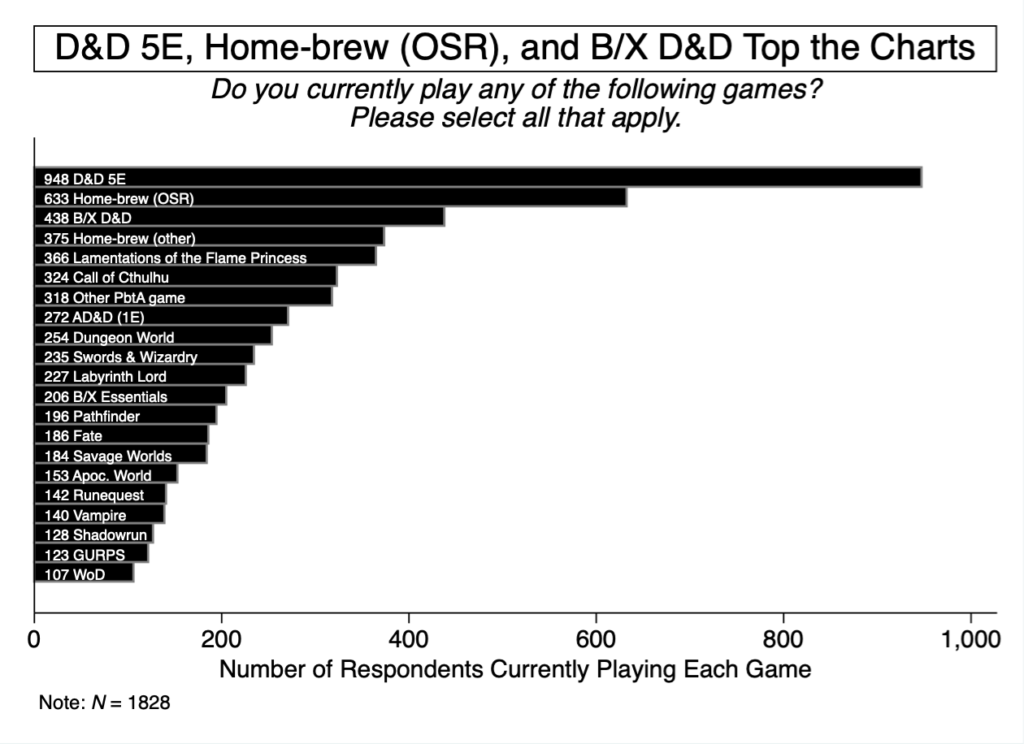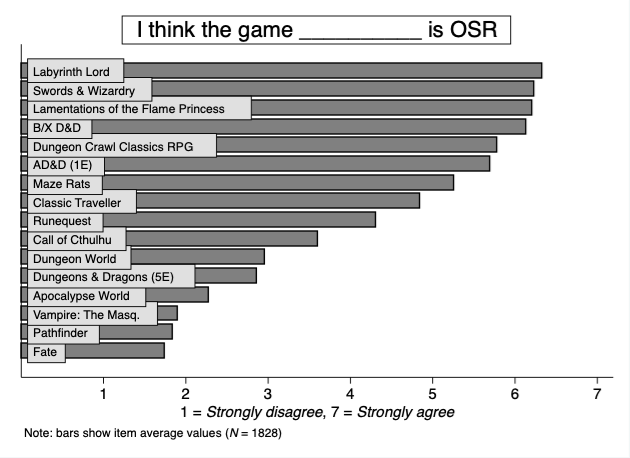(This is part of an ongoing discussion of the 2018 OSR Survey results. See the table of contents at the bottom of this post for links to the other parts.)
Beliefs about the nature of OSR, according to previous exploration of the 2018 OSR survey responses, seem to cohere around three broad themes or aspects: OSR as rules tradition, OSR as commerce, and OSR as social scene. Of the three aspects, respondents overall agreed most strongly that OSR is a rules tradition. There was greater ambivalence around the other two aspects, with commerce rating lowest on average. This naturally leads to the question of what kinds of rules and which games seem most OSR. In this post, I will discuss which games survey respondents believed were most (and least) OSR.
According to respondents, the most OSR games, out of the games I asked about, are Labyrinth Lord, Swords & Wizardry, Lamentations of the Flame Princess, and B/X D&D, all scoring above 6 (Agree) on average, across all participants, with LL narrowly taking the top slot. The least OSR games are Fate, Pathfinder, and Vampire: The Masquerade, all scoring below 2 (Disagree) on average, across all participants. I think this set entails reasonable coverage, though there are a few unfortunate omissions in retrospect, such as the lack of OSRIC. Respondents seemed neutral about whether the classic non-D&D games counted as OSR, with Classic Traveller, Runequest, and Call of Cthulhu all hovering around the scale midpoint. I was moderately surprised to see how D&D 5E rated (less OSR than Dungeon World!), given the high regard many people in my circles seem to have for this edition. This is speculation, but I suppose this means that the dominant associations respondents have with D&D 5E remain mainstream trends such as adventure paths, character builds, and tactical set-piece combats. The games respondents rated as least OSR seem to have associations with narrative focus (Apocalypse World, Vampire, Fate) and D&D 3E (Pathfinder).
Near the end of the survey, I asked respondents which games they were currently playing. Respondents could select all that applied from the following list: B/X D&D, D&D 5E, Pathfinder, Home-brew (OSR), Home-brew (other), Vampire, Lamentations of the Flame Princess, Swords & Wizardry, Apocalypse World, Dungeon World, Other PbtA game, Other World of Darkness game, Labyrinth Lord, B/X Essentials, AD&D (1E), GURPS, Shadowrun, Call of Cthulhu, Runequest, Fate, and Savage Worlds. Combining these reports of play behavior with the aggregate OSR ratings of games described above allowed me to compute an OSR play behavior score for each respondent. More on this in a future post.
On average, respondents reported currently playing 3.26 different games (SD = 2.51). 34 respondents (1.86% of N = 1828) reported playing more than 10 different games currently, including one respondent that checked all 18 game options, which seems implausible, but I am going to chalk that up to careless responding/measurement error and expect sample size to wash out that messiness. Without those 34, the average number of different games played drops to 3.08 games (SD = 2.16), but I keep them for all following results, as I predetermined all exclusion criteria.

Unfortunately, the survey lacked an option to indicate playing DCC, which I suspect would have a substantial number of current players. That was an oversight on my part. I did include an open ended item for other games played, and 142 respondents indicated playing DCC there. Additionally, the two World of Darkness related items were Vampire (or other WoD) and Other World of Darkness game, which overlap. (Clearly I should have proofread this set of options more carefully.) The headline results here are the popularity of D&D 5E (which indicates the power of the market leader) and the popularity of games genealogically related to B/X D&D. In fact, in terms of the games people are actually playing, based on these results one could view OSR as a vehicle for propagating the B/X vision of D&D.
For those unaware, the B/X D&D rules tradition started with the Moldvay Basic rules (covering character levels 1 through 3) and the Cook/Marsh Expert rules (covering character levels 4-14). It continued with the Mentzer-initiated BECMI line (covering character levels 1-36 and collected in the 1991 Rules Cyclopedia), which TSR supported in parallel with the Advanced Dungeons & Dragons line. The B/X line lineage is notable for simple rules and treating character class as a more general abstraction, rather than something closer to profession. For example, “elf” is a class in B/X. Arguably, the modern “playbook” trend derives from the B/X notion of class.
As always, let me know in the comments if anything is unclear, if you have any questions, or if you have any suggestions.


“This is speculation, but I suppose this means that the dominant associations respondents have with D&D 5E remain mainstream trends such as adventure paths, character builds, and tactical set-piece combats.”
Is this speculation based on anything aside from reading blogs? I mean, it seems right but it could seem right because it’s conventional wisdom rather than seeming right because it’s right.
@Scott
Conventional wisdom. Lacking some other evidence or logic, conventional wisdom seems like a reasonable place to start. Unambiguously, respondents reported D&D 5E was much less OSR compared to other games.
Do you have any other ideas about why this might be?
Maybe many people share my view that 5th Ed. is a game suited for “oldschool play”, but really is not part of the “OSR scene”.
I agree that 5th Edition is “not an OSR game”, but I also think it’s a good match for applying oldschool principles as a GM.
Yeah, I suspect folks made a distinction between whether 5e “is” an OSR game as-is and whether it can be made to play in an OSR fashion.
Or to put it another way – the circle of games that *can* be (and often are) played/run in an OSR way is much larger than the circle of games that is explicitly *designed* to be played/run in an OSR way.
One might understandably only call games in the latter circle “OSR games” while still playing lots of games in the former circle.
Pingback: GURPS, the OSR, and a game survey - Gaming Ballistic
Through play-by-post sites like RPOL.net and forum games, it’s possible to be in quite a few games simultaneously. So some of those people claiming to play 10+ systems at the same time may not be anomolies. No way to prove whether those are errors or outliers, but it is possible. I’m in 9 games on RPOL but with system overlaps (two Classic D&D, two AD&D1E, two Star Frontiers, and three 5E).
@Dennis
I agree. Though, I think you would show up as playing 3-4 different games in the data if you had responded consistent with this comment, as the item asks yes/no by system, and there was no option for Star Frontiers. 3-4 is pretty far from 10 (or 18). But yes, those high numbers are possible.
For the currently playing graph I would be interested in seeing how many system people pick and whether there any correlations between choices.
My opinion is that hobbyists rarely just use one system. For example they may mostly play D&D 5th edition but occasionally will play Classic Traveller.
@Robert
You can see the tetrachoric correlation matrix here.
In the heatmap color coding, tint represents magnitude of correlation, hue represents significance level, and warm/cool represents positive/negative relationship.
Variables are binary: 1 = playing, 0 = not playing.
Let me know if any of the variable names are unclear.
Pingback: CAR-PGa NEWSLETTER, Vol. 28, No. 2, February 2019 – CAR-PGA
Pingback: Financiamento Coletivo: Old-School Essentials – RPG News